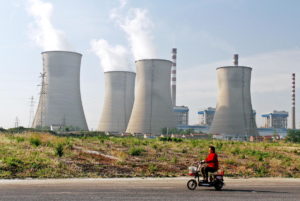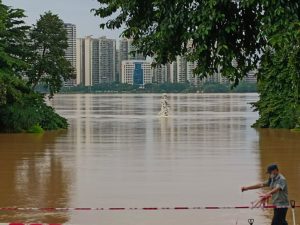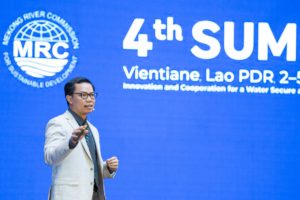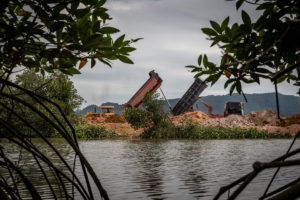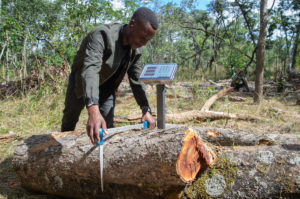The expansion of renewables in China has maintained an impressive pace over the last 10 to 15 years. In 2005, the introduction of the Renewable Energy Law established feed-in-tariffs (FiTs) to encourage renewables development. Since then, annual growth of wind and solar power in China has accounted for half, if not more, of the global total. For some time after 2010, China saw annual wind power capacity expansion of 20–35 gigawatts (GW), while solar grew even faster, with 30–50 GW added annually. In the five years from 2015, the two combined added 50–60 GW annually.
Despite the impact of Covid-19, strong renewables growth has continued since 2020, with over 100 GW of wind and solar added annually. In 2022, 150 GW of new renewable capacity, including hydro, wind, solar and bio power, was added, according to figures released by the National Energy Administration (NEA) in February. Wind and solar accounted for 125 gigawatts of the total new capacity and for 13% of all generated electricity. Globally the proportion is 10%.
According to the NEA figures, renewables generation in 2022 avoided about 2.26 billion tonnes of carbon dioxide emissions. Using the benchmark for coal power generation of 300 grams of coal per kilowatt hour, this would mean a kilowatt hour of renewables generation reduces carbon emissions by 837 grams. But we believe the reduction in emissions from renewables has been overestimated, particularly considering the operational and investment impacts of China’s “new energy bases” – large-scale renewable energy development projects, primarily located in the country’s remote western regions. These bases are spurring additional investment in coal power, with the renewable and fossil sources of power bundled together for transmission to eastern provinces. Furthermore, there are issues with how such installations are integrated into the grid.
Renewables and coal, advancing side by side
The extent to which renewable energy substitutes for traditional electricity generation and so reduces greenhouse gas emissions is a topic of deliberation by academics, policymakers and the electricity industry.
Emissions vary according to the characteristics of the power system, but the main variable is the form of power that is “crowded out” by new wind or solar.
Around the world, systems designed to minimise costs typically use an “economic dispatch” approach that ranks generation facilities by marginal cost, prioritising the cheapest. So, when new renewable energy generation comes online it competes with existing facilities and squeezes out any generation that’s more expensive – along with the associated emissions.
If, as can be the case in Scandinavia, the most expensive facility is hydropower, the emissions reductions may be practically zero. But if the most expensive generation is gas-fired power, the reductions in carbon dioxide per kilowatt hour will be somewhere between 400g and 600g. This would have been the case in most of western Europe during 2022, as gas prices were so high.
What about in China or India where coal accounts for 50% and above of all generation? If a coal-fired plant is outcompeted by new renewable generation, the reduction in emissions can be even higher, at around 700–1,000g per kilowatt hour depending on the energy efficiency of coal conversion. The above NEA figures assume 100% substitution for coal, which represents the biggest impact under ideal circumstances. However, the economic dispatch approach is not currently used in China.
In China, a significant part of new generation capacity is not connected to the local grid so does not substitute for existing generation. Quite a lot of China’s wind and solar expansion through its new energy bases is in the country’s western regions, which are less populated, less economically developed, and have less demand for power. Renewable generation is bundled with new or existing coal power and sent via dedicated ultra-high-voltage (UHV) transmission lines to eastern coastal provinces. Provisions for renewable energy development in the 14th Five Year Plan, China’s policy blueprint for 2021–25, required that renewables account for no less than 50% of the “hydro, wind, solar and coal” mix. And as there are some hydropower-only transmission lines that provide 100% renewable electricity, even a coal power contribution of 70% through other lines may be able to meet that average requirement. Those arrangements meant investment in renewables triggered a net expansion in coal power; in other words, without that wind and solar investment, the associated coal power construction and generation would not have happened. The two are complementary. Records for existing transmission lines (for 2021, 2020 and 2019) confirm this: wind and solar accounts for 20–40% of power sent by most cross-regional transmission lines. A new line planned to run from Hami in Xinjiang to Chongqing will come with 10 GW of renewable generation and 4–6 GW of coal power.
Does renewable energy generation in the west of China reduce investment in and operation of coal power assets in the east? It certainly doesn’t reduce investment. Electricity systems use an “N-1 Criterion” to ensure safe operation. This means the system should be able to maintain normal operation if any one part fails, so eastern regions must ensure they can meet local power demand if an entire transmission line goes down. They do this in part by using coal power to act as backup in case of emergency. Given that coal power facilities have a lifespan of 35–40 years, compared to around 20 years for wind and solar, there is a risk that investment in coal power to meet N-1 and backup requirements will lock in long-term emissions.
And in actual operations, the substitution of coal by renewables is nowhere near a 1:1 ratio. Instead, 70% of coal power produced in western China and 30% of wind and solar is used to substitute for fossil-fuel generation in the east of the country. Most often this means one coal power facility substitutes for another. Even if the incoming facility is more efficient and so embodies less carbon, those benefits are undercut by significant long-distance transmission losses, local units in the east running less efficiently because they must adapt to inflexible imports of power, and local transmission losses.
So increased renewables capacity does not necessarily replace fossil fuel generation as might be expected. We did some calculations for the long-distance transmission line between Hami in Xinjiang and Zhengzhou in Henan, which has been in operation for some years. The line is 2,200 kilometres long, is rated for 8 GW, and sees transmission losses of 7.2%. Associated generation capacity includes 8 GW of wind, 1.25 GW of solar and 6.6 GW of coal power, for a total of 15.85 GW. We found that the emissions reductions from the policy of requiring renewables to account for no less than 50% of the hydro, wind, solar and coal mix were cut by 360g of CO2 per kilowatt hour, compared to the ideal case. In actual practice, further addition of coal power (the percentage is commonly 70% or even higher) reduced the emission reduction effects by almost 100g. Transmission efficiencies cut reductions further, by over 50g. Even ignoring further contraction in efficiency at the destination, actual emissions reductions are around 356g per kilowatt hour – about 40% of a straight coal-to-renewables substitution, and approximately equivalent to a coal-to-gas switch.
In terms of climate and emissions, renewables are more like natural gas.
Moreover, this leads to extra coal power investment that risks locking in emissions for longer. Of course, someone may argue that the extra coal power is temporary and will be withdrawn when emissions need to peak and start to fall. The capacity will therefore not necessarily mean the proportional coal consumption and carbon emissions. In theory, this is possible. Yet it is more likely that coal power will continue to be used as currently, if not more so. China’s electricity system still lacks a mechanism for competition based on short-term marginal cost – in other words, it does not use the economic dispatch method – and the increasing percentage of renewables hooked up to transmission lines also means lower utilisation rates, due to intermittency of renewables. Keeping current transmission prices will further delay investment pay-back for the transmission lines. But if prices are raised, the electricity delivered will become less competitive or prices paid to the generators in western regions will decrease. Whatever happens will be in conflict with the political and economic interests of various powerful stakeholders.
How much of China’s renewable energy is bundled with coal?
Figures are incomplete, but there are over 20 projects that are similar to the Hami–Zhengzhou transmission line (please contact the author for the full list). One third are dedicated hydropower lines in the south-west of the country. About 50% of the generating capacity for the other lines is coal power. That allows us to estimate that 35–40% of the wind and solar power capacity built in the last five years has been bundled like this with coal power.
If wind and solar power fail to have the expected impact on emissions, there will be obvious consequences for global power generation data and our understanding of renewable energy development. The Intergovernmental Panel on Climate Change’s Sixth Assessment Report identified wind and solar power as the most promising of the cost-effective mitigation options, with a particularly important role to play up to 2030, as other options are either impractical, hard to scale up, or too expensive. According to International Energy Agency calculations, the solar power sector is already on course to be aligned with a 1.5C global warming scenario as of 2030, if already-announced solar power plans are included. Figures compiled by Bloomberg found that 85% of power generation capacity added in 2021 came from renewables, primarily solar and wind. MCC, a Berlin-based energy and climate think tank, included this on its 2022 climate good news advent calendar. But all these are based on the assumption that renewable energy would replace fossil fuels and so reduce emissions sufficiently.
Despite China’s accelerating growth in renewable energy, the increase in the proportion of renewables in the power mix has not been so prominent. Meanwhile, coal consumption and emissions continue to grow, perhaps even rapidly. A major factor in this is coal–renewables complementarity. Non-official calculations for 2021 show that China’s greenhouse gas emissions were up 5.9% on 2019. In 2022, generation from renewables grew significantly, by almost 2%. That year saw pricing distortions reduce generation from coal power and a resulting two-week power rationing in Sichuan. The fall in coal power generation “exaggerated” renewable generation in percentage terms. Preliminary figures for 2022 indicate that coal consumption went up 3% or more compared to 2021, to a new high. Emissions, meanwhile, may have gone up by more than 1.5% despite the impact of strict Covid lockdowns.
Why are renewables bundled with coal?
The bundling of wind and solar power with coal makes no economic sense. Existing long distance transmission lines have no interconnection function along the way that would allow for flexible dispatch of power between regions. In terms of balancing supply and demand, the most stable, practical and cost-effective approach is to generate, distribute and consume power more locally. For example, connecting the Northwest China Grid and the North China Grid would require a connection of only 500kV or lower, stretching no more than a few hundred kilometres at most. That means shorter, lower-capacity requirement and cheaper transmission lines than in the new energy base approach, which takes no account of local need. So why the long-distance inflexible transmission model? It may be down to political-economic issues, in particular how central and local governments interact and share fiscal revenue.
Recently, signs have emerged of changes to this approach to expand renewables. The long-distance transmission model does not take account of changes in supply and demand across the generation and consumption ends, making it harder to make operational adjustments and ensure energy security. Given the rapidly changing international environment, this is definitely a weak point in China’s energy and power security. In November 2022, a grid executive speaking at the annual meeting of the China Electricity Council said it would: “insist on the localised balance (prioritising local resources and infrastructure), and help maintain regional balance when necessary, work to resolve a lack of capacity to help respond to peak emergency demand, and ensure safety.” At the National Energy Administration press conference mentioned earlier, the role of “Chinese-style” distributed solar was highlighted. However, we do not think that distributed or centralised generation is the issue at hand. It is the need for a single market, flexible grid integration, and developing wind and solar while taking into account the nature of those power sources.
China’s new energy bases are not inherently problematic, as they offer a valuable resource in the form of cheap and abundant renewable energy. However, to maximise the benefits of this resource, these bases should be built without accompanying coal power generation and without the installation of high-cost and inefficient transmission lines that do not account for dynamic demand. Instead, these bases should be recalibrated to facilitate normal grid connections or re-purposed for the production of e-fuels, such as hydrogen, ammonia, or methane. This approach would help address the emissions issue associated with the current approach while also enhancing competitiveness. Given recent dynamics mentioned above, we find cause for optimism.
A similar situation, with renewables capacity not leading to emissions reductions, could be found outside China when economic dispatch principles are not applied, for example in Southeast Asia, Central and Western Asia, and India. Analysis of specific cases is needed to come up with practical solutions.
Electricity system reforms and climate security must go hand in hand
We have wind and solar power generation which is generally cheaper than traditional sources of power. This is necessary for quick and affordable decarbonisation of the power sector, but it is not sufficient. In most developing nations, flexibility improvements associated with the integration of renewables to the grid (rapid stop-starts, quicker ramp rates, minimum output level) and operational reforms (more granular economic dispatch), and market coordination mechanisms (for example, bigger, faster and shorter market segments) need to evolve in parallel.
In China, significant electricity curtailment (wastage) issues were seen when the grid started to integrate wind and solar power. This was due to a lack of flexibility in the grid and the system operation, which meant the additional capacity could not always be used. This has been resolved by a regulatory focus on curtailment rates. Yet, despite the huge additional generation of new renewables achieved, emissions reductions are not always fully realised due to system-level factors that impede their translation into tangible environmental benefits.
While we are cautiously optimistic, we need to make it clear that electricity reforms and climate security must go hand in hand. United, both will succeed; split, both will fail.


